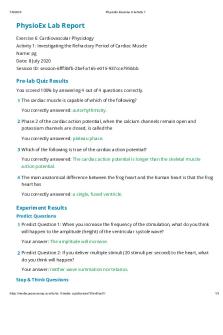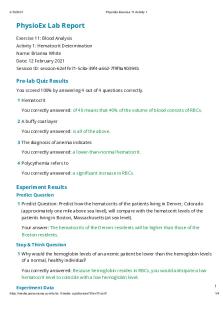Physio Ex Exercise 12 Activity 1 PDF

| Title | Physio Ex Exercise 12 Activity 1 |
|---|---|
| Course | Anatomy & Physiology Lab II |
| Institution | West Georgia Technical College |
| Pages | 4 |
| File Size | 59.2 KB |
| File Type | |
| Total Downloads | 109 |
| Total Views | 139 |
Summary
I hope this helps these are the PhysioEx labs we were prompted to conduct in class....
Description
3/13/2021
PhysioEx Exercise 12 Activity 1
PhysioEx Lab Report Exercise 12: Serological Testing Activity 1: Using Direct Fluorescent Antibody Technique to Test for Chlamydia Name: Alexus Fuller Date: 13 March 2021 Session ID: session-56461ca0-5dc0-4b2e-1ba9-bf732a69899f
Pre-lab Quiz Results You scored 100% by answering 4 out of 4 questions correctly. 1 Which of the following has an epitope? You correctly answered: an antigen. 2 Chlamydia trachomatis is You correctly answered: a bacterium that reproduces inside its host cell. 3 The infectious form of Chlamydia that is spread from person to person is the You correctly answered: elementary body that stains green in this activity. 4 The goal of the direct fluorescent antibody test is to test for the presence of You correctly answered: antigen.
Experiment Results Predict Questions No Predict Questions Stop & Think Questions 1 The source of the patient samples is You correctly answered: epithelial scrapings. 2 What is the name for the specific part of the antigen that the antibody binds to? You correctly answered: epitope. 3 Drag the first slide (patient A) to the fluorescent microscope. Count the number of elementary bodies you see through the microscope (recall that elementary bodies stain green), enter the number of elementary bodies. https://media.pearsoncmg.com/bc/bc_0media_ap/physioex/10/ex12/act1/
1/4
3/13/2021
PhysioEx Exercise 12 Activity 1
You answered: 0 elementary bodies. 4 Drag the next slide (patient B) to the fluorescent microscope. Count the number of elementary bodies you see through the microscope (recall that elementary bodies stain green), enter the number of elementary bodies. You answered: 17 elementary bodies. 5 Drag the next slide (patient C) to the fluorescent microscope. Count the number of elementary bodies you see through the microscope (recall that elementary bodies stain green), enter the number of elementary bodies. You answered: 1 elementary bodies. 6 Drag the next slide (positive control) to the fluorescent microscope. Count the number of elementary bodies you see through the microscope (recall that elementary bodies stain green), enter the number of elementary bodies. You answered: 19 elementary bodies. 7 Drag the last slide (negative control) to the fluorescent microscope. Count the number of elementary bodies you see through the microscope (recall that elementary bodies stain green), enter the number of elementary bodies. You answered: 0 elementary bodies. Experiment Data Sample
Number of Elementary Bodies
Chlamydia Result
Patient A
0
-
Patient B
17
+
Patient C
1
+
Positive Control
19
+
Negative Control
0
-
Post-lab Quiz Results You scored 80% by answering 4 out of 5 questions correctly.
https://media.pearsoncmg.com/bc/bc_0media_ap/physioex/10/ex12/act1/
2/4
3/13/2021
PhysioEx Exercise 12 Activity 1
1 In the serology test just performed, the fluorescence is found on the You correctly answered: antibody. 2 What would most likely happen if you forgot to fix the samples to the slide? Your answer: They would all test positive because the washing steps would remove the samples. Correct answer: They would all test negative because the washing steps would remove the samples. 3 Which sample showed some residual nonspecific binding after the washing steps? You correctly answered: patient C. 4 Which patient samples contained the Chlamydia -specific antigen? You correctly answered: patient B. 5 How is chlamydia disease transmission prevented? You correctly answered: abstinence or faithful, mutual monogamy.
Review Sheet Results 1 Describe the importance of the washing steps in the direct antibody fluorescence test. Your answer: The washing steps in the direct antibody fluorescence test is important because it removes any non-specific binding of antigens and antibodies. 2 Explain where the epitope (antigenic determinant) is located. Your answer: Epitopes are located in an antigen where the antibody can bind to it. 3 Describe how a positive result is detected in this serological test. Your answer: To test positive for a serological test, there must be ten or more fluorescent antibodies must be found within 5 mm. 4 How would the results be affected if a negative control gave a positive result? Your answer:
https://media.pearsoncmg.com/bc/bc_0media_ap/physioex/10/ex12/act1/
3/4
3/13/2021
PhysioEx Exercise 12 Activity 1
The entire expierment would need to voided in its entirety because there would be nothing to base it off if the control gave a positive result.
https://media.pearsoncmg.com/bc/bc_0media_ap/physioex/10/ex12/act1/
4/4...
Similar Free PDFs

Physio Ex Exercise 12 Activity 1
- 4 Pages

Physio Ex Exercise 1 Activity 1
- 4 Pages

Physio Ex Exercise 1 Activity 1
- 4 Pages

Physio Ex Exercise 1 Activity 1
- 4 Pages

Physio Ex Exercise 1 Activity 1
- 4 Pages

Physio Ex Exercise 11 Activity 1
- 4 Pages

Physio Ex Exercise 6 Activity 1
- 3 Pages

Physio Ex Exercise 7 Activity 1
- 6 Pages

Physio Ex Exercise 7 Activity 1
- 5 Pages

Physio Ex Exercise 1 Activity 2
- 3 Pages

Physio Ex Exercise 1 Activity 2
- 3 Pages

Physio Ex Exercise 2 Activity 1
- 6 Pages

Physio Ex Exercise 3 Activity 1
- 8 Pages

Physio Ex Exercise 6 Activity 1
- 3 Pages

Physio Ex Exercise 11 Activity 1
- 4 Pages
Popular Institutions
- Tinajero National High School - Annex
- Politeknik Caltex Riau
- Yokohama City University
- SGT University
- University of Al-Qadisiyah
- Divine Word College of Vigan
- Techniek College Rotterdam
- Universidade de Santiago
- Universiti Teknologi MARA Cawangan Johor Kampus Pasir Gudang
- Poltekkes Kemenkes Yogyakarta
- Baguio City National High School
- Colegio san marcos
- preparatoria uno
- Centro de Bachillerato Tecnológico Industrial y de Servicios No. 107
- Dalian Maritime University
- Quang Trung Secondary School
- Colegio Tecnológico en Informática
- Corporación Regional de Educación Superior
- Grupo CEDVA
- Dar Al Uloom University
- Centro de Estudios Preuniversitarios de la Universidad Nacional de Ingeniería
- 上智大学
- Aakash International School, Nuna Majara
- San Felipe Neri Catholic School
- Kang Chiao International School - New Taipei City
- Misamis Occidental National High School
- Institución Educativa Escuela Normal Juan Ladrilleros
- Kolehiyo ng Pantukan
- Batanes State College
- Instituto Continental
- Sekolah Menengah Kejuruan Kesehatan Kaltara (Tarakan)
- Colegio de La Inmaculada Concepcion - Cebu
